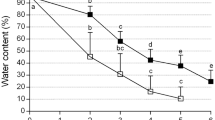Abstract
Node cultures ofGypsophila paniculata showed vitrified growth when cultured under standard conditions, resulting in poor survival of tissue culture derived plants. The deviant growth pattern appeared to be determined in the lag phase of the cultures. A limited evaporation period in this stage induced normal growth. Re-establishment of high relative humidity and poorer gas exchange thereafter did not lead to vitrified growth. Vitrification was also depressed when evaporation was continued during the whole culture period, but shorter plantlets resulted. A simple adaptation of the plastic lid that is commonly used in micropropagation, allowed controlled and contamination-free evaporation.
Similar content being viewed by others
References
Bradford AJ, Yang S (1981) Physiological responses of plants to waterlogging. HortScience 16: 25–30
Brainerd KE, Fuchigami LH (1981) Acclimatization of aseptically cultured apple plants to low relative humidity. J Amer Soc Hort Sci 106: 515–518
Debergh P, Harbaoui Y, Lemeur R (1981) Mass propagation of globe artichoke (Cynara scolymus): evaluation of different hypotheses to overcome vitrification with special reference to water potential. Physiol Plant 53: 181–187
De Proft MP, Maene L, Debergh PC (1985) Carbon dioxide and ethylene evolution in the culture atmosphere ofMagnolia cultured in vitro. Physiol Plant 65: 375–379
Hakkaart FA, Versluys JMA (1983) Some factors affecting glassiness in carnation meristem tip cultures Neth J Plant Path 89: 47–53
John A (1986) Vitrification in Sitka spruce cultures. In: Withers LA, Alderson PG (Eds) Plant Tissue Culture and its Agricultural Applications (pp 167–174) Butterworths, London
Kawase M (1981) Anatomical and morphological adaptation of plants to waterlogging. HortScience 16: 31–34
Leshem B (1983) The carnation succulent plantlet-a stable teratological growth. Ann Bot 52: 873–876
Maene LJ, Debergh PC (1987) Optimalisation of the transfer of tissue-cultured shoots to in vivo conditions. Acta Hort 212: 335–348
Murashige T, Skoog F (1962) A revised medium for rapid growth and bioassays with tobacco tissue cultures. Physiol Plant 15: 473–497
Wardle K, Dobbs EB, Short KC (1983) In vitro acclimatization of aseptically cultured plants to humidity. J Amer Soc Hort Sci 108: 386–389
Ziv M (1986) In vitro hardening and acclimatization of tissue culture plants. In: Withers LA, Alderson PG (Eds) Plant Tissue Culture and its Agricultural Applications (pp 187–196) Butterworths, London
Ziv M, Meir G, Halevy AH (1983) Factors influencing the production of hardened glaucous carnation plantlets in vitro. Plant Cell Tissue Organ Culture 2: 55–65
Author information
Authors and Affiliations
Rights and permissions
About this article
Cite this article
Dillen, W., Buysens, S. A simple technique to overcome vitrification inGypsophila paniculata L.. Plant Cell Tiss Organ Cult 19, 181–188 (1989). https://doi.org/10.1007/BF00043345
Received:
Accepted:
Issue Date:
DOI: https://doi.org/10.1007/BF00043345



